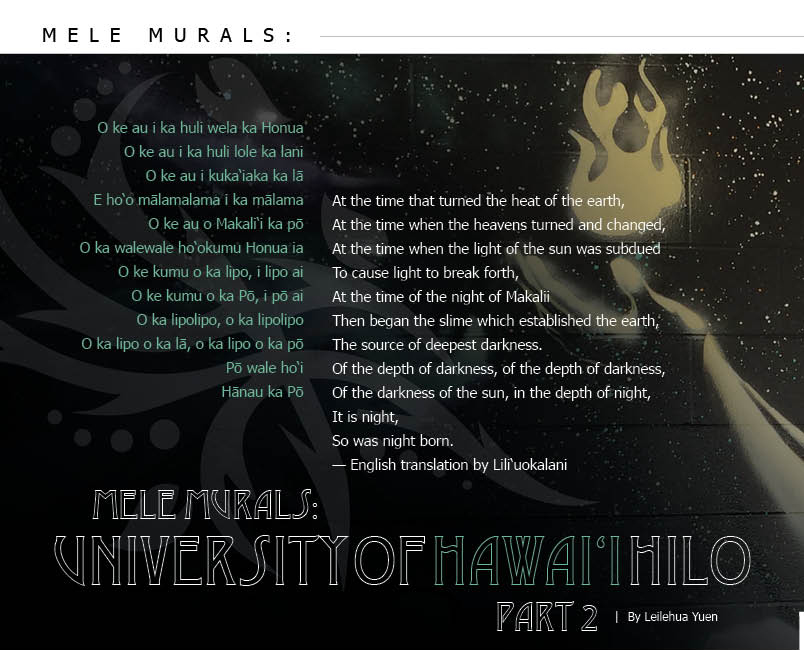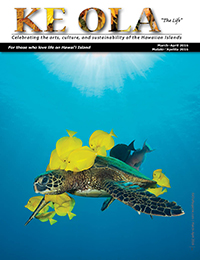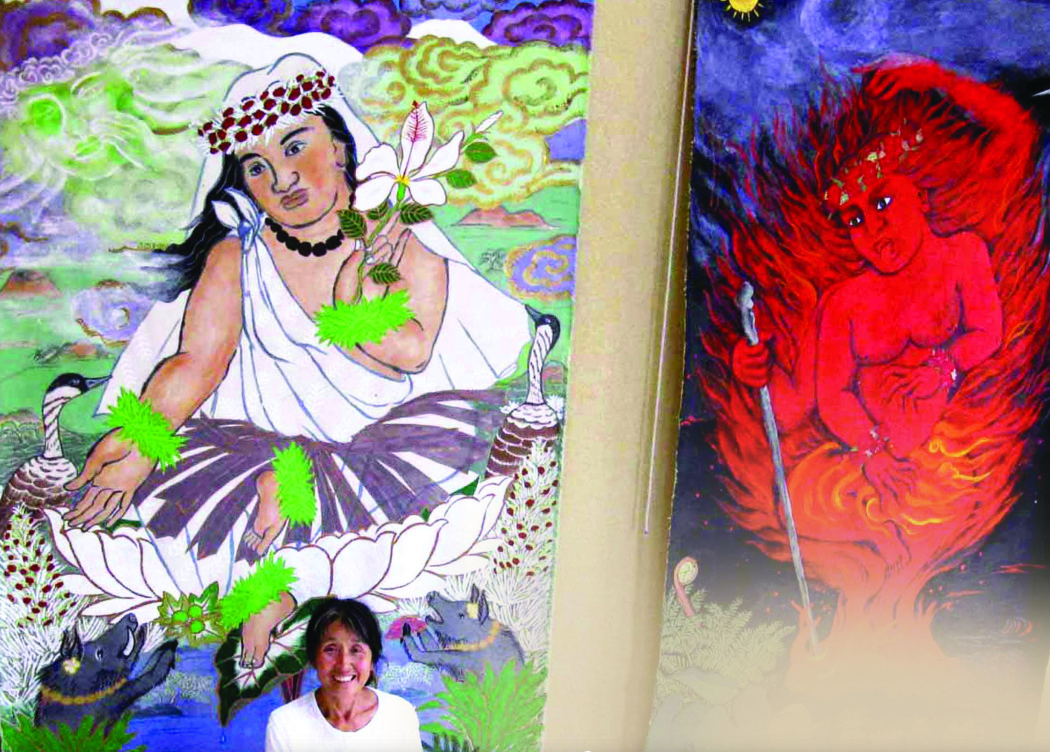
Mele Murals: University of Hawai‘i Hilo, Part 2
 By Leilehua Yuen
By Leilehua Yuen
| O ke au i ka huli wela ka Honua O ke au i ka huli lole ka lani O ke au i kuka‘iaka ka lā E ho‘o mālamalama i ka mālama O ke au o Makali‘i ka pō O ka walewale ho‘okumu Honua ia O ke kumu o ka lipo, i lipo ai O ke kumu o ka Pō, i pō ai O ka lipolipo, o ka lipolipo O ka lipo o ka lā, o ka lipo o ka pō Pō wale ho‘i Hānau ka Pō |
At the time that turned the heat of the earth, At the time when the heavens turned and changed, At the time when the light of the sun was subdued To cause light to break forth, At the time of the night of Makalii Then began the slime which established the earth, The source of deepest darkness. Of the depth of darkness, of the depth of darkness, Of the darkness of the sun, in the depth of night, It is night, So was night born. — English translation by Lili‘uokalani |
The Kumulipo, a ko‘ihonua, or genealogical chant, comprised of some 2,000 lines, establishes the ancestry of the Kalākaua lineage from the beginning of time. As such, it also establishes the genealogy of the Hawaiian people. Lili‘uokalani cited the 18th century prophet and poet, Keaulumoku, as the composer.
The Kumulipo is the most renowned of Hawaiian cosmolgical chants. Its comprehensive depiction of cosmic relationships provides a foundation for understanding Hawaiian perspectives on many aspects of life.
The second Mele Mural project at the University of Hawai‘i at Hilo depicts concepts of the Kumulipo at Hale ‘Ikena, the apartment-style residence hall on campus. ‘Ikena means view, seeing, knowing, association, scenery, and knowledge. It is a perfect name for the location of the Kumulipo mural. Kamalani Johnson, the Papakū advisor for the mural says, “We didn’t plan for the name to match the mural like that, but it did work out.”
Kamalani’s initial involvement in the Mele Mural project was in fall of 2014, when he was a senior at UH Hilo. He found the experience so rewarding that the next summer he signed on as a professional staff member. As the Kupa ‘Āina Summer Bridge Program Activities Coordinator, he had the opportunity to expand on his creative involvement with the first mural and coordinate the second.
The Estria Foundation youth development project combines arts education, cultural preservation, and community building.
All of the murals, which have been developed under the program, give nā ‘ōpio (youth), makua (parents), and kūpuna (elders) a way to share across generations. Depicting the Kumulipo, a chant which is foundational to so much of the Hawaiian world view and an integral part of the Hawaiian programs at UH Hilo, provides an even deeper sense of place and gives students from all cultures a visual referent for the history and heritage of the islands.

To develop the artistic concept, the students studied the chant and explored its relevance to their lives. They then created their renderings. Before applying paint to the walls of the building, the students practiced on a shipping container in the parking lot. They explored depictions of ‘aumākua—family guardians or deities—and learned how to scale their concepts into larger-than-life actualities.
On the Komohana (western) side of Hale ‘Ikena is a wall composed of hollow tile pillars. They have been painted in the billows and swirls of deep space formations, and spell out “Kumulipo.”
Following the word and heading around the corner, Kāne, one of the creator deities, brings forth from his ipu—the gourd—a many-seeded fruit, the depth of night and darkness from which all of creation will grow.
The roiling cosmos spill along the wall, and a celestial hand releases a voyaging canoe into the ocean of space. The juxtaposition of ancient voyaging tradition and modern motorcycles and scooters brings a smile and sense of continuity. A dual-sport bike looks ready to ride to galactic center.
Hina, the cosmic feminine appears. She holds a flame, a seed, light: she nurtures creation.
Continuing around Hale ‘Ikena, ‘io, the high flying hawk, an ‘aumakua and symbolic of ‘ike—to see with knowledge and understanding—flies high against the sunlit clouds.
A mo‘o, another ‘aumakua, rests on the wall. The word, mo‘o, has many definitions. A lizard or dragon, a story, or a genealogical line. All are appropriate in this context.
Next, Hāloa, the kalo plant and ancestor of the Hawaiian people, is depicted. The infant Hāloa is the rootstock, the kumu of the Hawaiian people, and teaches us how to live.
Around the corner, the waters, source of life, flow down the mountains to the sea. Hilo’s iconic Wai ‘Ānuenue (Rainbow Falls) tumbles over it’s pali, veiling Hina’s cave. At the shore, a he‘e, the octopus kinolau (body form) of Kanaloa—sea god and friend of Kāne—rests in the shallows.
A planter filled with kalo, heart-shaped glossy green leaves waving gently, is a good place to pause and see Aloha. This small mural within the mural depicts Mauna Kea graced by a rainbow, a spiral galaxy of clouds swirling above, bright sun shining down, and the waters for which Hilo is famous flowing down the mountain.
Near it is the Kumulipo wall. We have come full circle, back to our source.
The Legend of Hāloa
Excerpt from the story as told
by Leilehua Yuen
Much Hawaiian culture is based on taro cultivation. For example, you cannot fight, argue, or discuss unpleasant things when the bowl of poi is open. By ancient Hawaiian custom, it is considered disrespectful to fight in front of an elder. One should not raise their voice, speak angrily, or make rude comments or gestures. How is this connected to an open poi bowl? Because Hāloa (Taro) is the elder brother of humans.
The ancient Hawaiians identified so strongly with taro that the Hawaiian term for family, ‘ohana, is derived from the word ‘oha, the shoot or sucker which grows from the taro corm. As the young shoots grow from the corm, people grow from the family.
A New Land
The fine lauhala sail that Ho‘ohokukalani had plaited caught the wind, and the couple was sailing from the land between the clouds to the ocean below. The narrow bow of the canoe sliced through wavelets as it skimmed across the water. Soon, they reached Hawai‘i.
They sailed by various shores, and at last found a valley that could be their home. Wākea beached the canoe and set about building a hale for himself and Ho‘ohoku.
First he selected the site. Then, Wākea went to the beach and carried rocks to build the lower wall. He went to the forest and used his stone adz to cut trees for the house posts. He put the bases into holes in the ground and built the stone wall up around them. Then he added the roof poles. He had to cut many fine saplings to make enough ribs to tie the thatching to.
While he built the frame, Ho‘ohoku collected ti leaves and tied them into bundles for the thatch. Wākea spread ‘ili‘ili (pebbles) for the floor and covered them with fine sand.
Ho‘ohoku plaited lauhala to make a floor covering to go over the sand. She trimmed the thorns from the leaves with her sharp bamboo knife. She softened the leaves by pulling them back and forth over the dull side of her knife. She coiled them one way and then the other. Then she began to coil them into wheels, with the diameter the same size as the length of her forearm. When she had enough wheels of leaves, she sorted them by color and decided on a pattern for her mat. Then, with her fingernails, she stripped the leaves into long narrow pieces and began to weave.
At last the hale was complete.
Whether it was because of the stress of the sea voyage, her mother’s curses, or some other reason, Ho‘ohoku began her labor too soon. It was long and painful, and Ho‘ohoku did not have her mother there to help her, but she did not scream or cry. At last, the baby was born.
This first child was premature, a legless, armless, formless lump of flesh. Ho‘ohoku and Wākea named him Hāloa-naka, but sadly he died. Wākea buried Hāloa-naka at the east corner of the house. Each day Ho‘ohoku tended the burial site. She carried water in Wākea’s ipuwai and gave Hāloa-naka a drink. She stirred the mud as if she were tucking a blanket around her baby. She kept the area clean and free of weeds and animals. In a few days, a tightly furled green leaf poked up through the mud. “Oh, Wākea,” she called, “Look at our son! See how he grows? He stands already!” Ho‘ohoku continued to care for her firstborn son, who grew into a large and handsome taro plant.
Later, Ho‘ohoku gave birth to a human child. He also was named Hāloa. He was perfect in form, intelligent, and handsome. He grew like any boy, and became a man. He became the ancestor of humans. He was taught to honor, respect, and care for his elder brother so that his brother always would watch over and care for him.
So now, even today, the descendants of Hāloa-the-elder provide nourishing food for the descendants of Hāloa-the-younger. ❖
Contact The Estria Foundation and Mele Murals
Contact writer Leilehua Yuen
Bibliography
Beckwith, Kumulipo, A Hawaiian Creation Chant
Kanaka‘ole Foundation, E Mau Ana o Kanaloa
Lili‘uokalani, The Kumulipo


